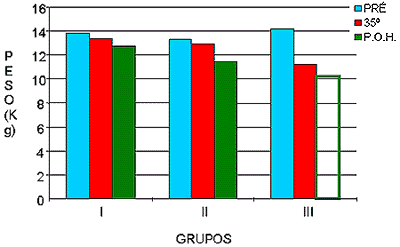The aim of this study was to evaluate in dogs the effects of two kinds of procedures in the gastroesophageal reflux prevention. Thirty animals divided in three randomized groups of ten were analysed as follow: group I (control) - esophagastrostomy side-to-side ; group II - esophagogastroplasty; group III -esophagogastrostomy side-to-side, partial gastrectomy and gastrojejunoanastomosis with excluded loop on y, The following parameters were used: body weight, endoscopy, radiological study and macro and microscopy data of the inner surface of the esophagus. The animals received daily histamine-in-beeswax parenterally for the posoperative stimulation of the gastric acid output until death or sacrifice. The research was carried out in three phases: préoperative phase, between the 35° and the 40° postoperative day and after histamine application. Group I showed sgnificant weight loss between the 1st and 2nd phase, which was intense on the 3rd phase. Group II showed no significative weight changes in any phase. Group III revealed significant weight changes even without histaminic stimulus. Endoscopy brought out significant more intensive esophagitis in group I than in II, after histaminic stimulus. In III, it was not possible to obtain these results, because of the precocious death of the animals. Fluoroscopic examination showed that 70% of the animals from group I, exhibited significative reflux, while in 30% this complication was not present. In group II, the reflux ocurred in few dogs and was not seen in 70% of the dogs.. Group III, revealed reflux in all animals and of significant manner in 70% of then. The macro and microscopic data did not show a significant difference among the groups, however the group II was the least committed. The results of this experiment demonstrated that the esophagogastrostomy side-to-side as expected produce intense esophageal reflux, the esophagogastroplasty showed minor morbidity and efficacy to impede the action of esophageal reflux and the surgery performed in group III, exhibited raised morbidity and early mortality after histamine stimulus. It is believed that the esophagogastroplasty takes reserved place in the procedures suggested to the treatment of achalasia and of peptique stenosis of the esophagus.
Megaesophagus; Achalasia; Peptic stenosis of the esophagus; Procedures






